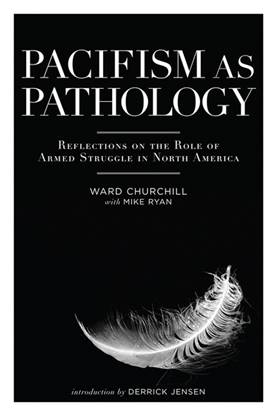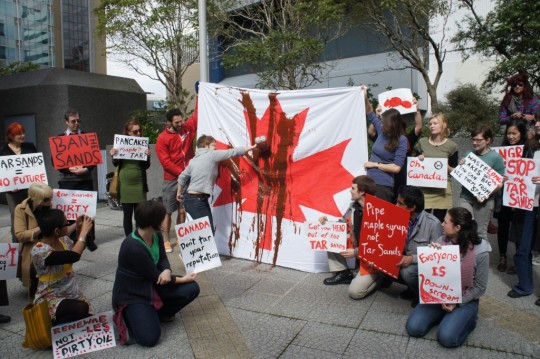Aug 30
201113
350.org / 1Sky, Greenpeace, Indigenous Environmental Network, Rainforest Action Network (RAN), Sierra Club
350.org Civil Disobedience Pacifism Tar Sands Action Ward Churchill
Eyes Wide Shut | The Tar Sands Action Protest & The Paralysis of a Movement – Excerpt
Eyes Wide Shut | The Tar Sands Action Protest & The Paralysis of a Movement
August 30th, 2011
Cory Morningstar
Following is an excerpt from Ward Churchill’s Pacifism as Pathology, first published in 1986. For anyone interested in mitigating the global collapse of all ecosystems and deterring planet-wide and species-wide genocide, this is essential reading.
For anyone wishing to take a critical look at the Tar Sands protests by groups funded (in some cases created) by the Rockefellers and other corporate foundations – who will stop at absolutely nothing to keep the current power structures intact – the excerpt from this essay is sure to wake one from the paralysis trapping and constraining movements and societies to the status quo. The parallels of Churchill’s essay and events in Washington DC being celebrated and endorsed, while the planet rests on the precipice, are nothing less than Orwellian.
The question central to the emergence and maintenance of nonviolence as the oppositional foundation of American activism has not been the truly pacifist formulation, “How can we forge a revolutionary politics within which we can avoid inflicting violence on others?” On the contrary, a more accurate guiding question has been, “What sort of politics might I engage in which will both allow me to posture as a progressive and allow me to avoid incurring harm to myself?” Hence, the trappings of pacifism have been subverted to establish a sort of “politics of the comfort zone,” not only akin to what Bettelheim termed “the philosophy of business as usual” and devoid of perceived risk to its advocates, but minus any conceivable revolutionary impetus as well.[55] The intended revolutionary content of true pacifist activism — the sort practiced by the Gandhian movement, the Berrigans, and Norman Morrison – is thus isolated and subsumed in the United States, even among the ranks of self-professing participants.
Such a situation must abort whatever limited utility pacifist tactics might have, absent other and concurrent forms of struggle, as a socially transformative method. Yet the history of the American Left over the past decade shows too clearly that the more diluted the substance embodied in “pacifist practice,” the louder the insistence of its subscribers that nonviolence is the only mode of action “appropriate and acceptable within the context of North America,” and the greater the effort to ostracize, or even stifle divergent types of actions.[56] Such strategic hegemony exerted by proponents of this truncated range of tactical options has done much to foreclose on what ever revolutionary potential may be said to exist in modern America.
Is such an assessment too harsh? One need only attend a mass demonstration (ostensibly directed against the policies of the state) in any U.S. city to discover the answer. One will find hundreds, sometimes thousands, assembled in orderly fashion, listening to selected speakers calling for an end to this or that aspect of lethal state activity, carrying signs “demanding” the same thing, welcoming singers who enunciate lyrically on the worthiness of the demonstrators’ agenda as well as the plight of the various victims they are there to “defend,” and – typically – the whole thing is quietly disbanded with exhortations to the assembled to “keep working” on the matter and to please sign a petition and/or write letters to congress people requesting that they alter or abandon offending undertakings.
Throughout the whole charade it will be noticed that the state is represented by a uniformed police presence keeping a discreet distance and not interfering with the activities. And why should they? The organizers of the demonstration will have gone through “proper channels” to obtain permits required by the state and instructions as to where they will be allowed to assemble, how long they will be allowed to stay and, should a march be involved in the demonstration, along which routes they will be allowed to walk. Surrounding the larger mass of demonstrators can be seen others — an elite. Adorned with green (or white, or powder blue) armbands, their function is to ensure that demonstrators remain “responsible,” not deviating from the state-arm banded sanctioned plan of protest. Individuals or small groups who attempt to spin off from the main body, entering areas to which the state has denied access (or some other unapproved activity) are headed off by these arm-banded “marshals” who argue — pointing to the nearby police – that “troublemaking” will only “exacerbate an already tense situation” and “provoke violence,” thereby “alienating those we are attempting to reach.”[57] In some ways, the voice of the “good Jews” can be heard to echo plainly over the years.
At this juncture, the confluence of interests between the state and the mass nonviolent movement could not be clearer. The role of the police, whose function is to support state policy by minimizing disruption of its procedures, should be in natural conflict with that of a movement purporting to challenge these same policies and, indeed, to transform the state itself.[58] However, with apparent perverseness, the police find themselves serving as mere backups (or props) to self-policing (now euphemistically termed “peace-keeping” rather than the more accurate “marshaling”) efforts of the alleged opposition’s own membership. Both sides of the “contestation” concur that the smooth functioning of state processes must not be physically disturbed, at least not in any significant way.[59] All of this is within the letter and spirit of cooptive forms of sophisticated self-preservation appearing as an integral aspect of the later phases of bourgeois democracy.[60] It dovetails well with more shopworn methods such as the electoral process and has been used by the state as an innovative means of conducting public opinion polls, which better hide rather than eliminate controversial policies.[61] Even the movement’s own sloganeering tends to bear this out from time to time, as when Students for a Democratic Society (SDS) coined the catch-phrase of its alternative to the polling place: “Vote with your feet, vote in the street.”[62]
Of course, any movement seeking to project a credible self-image as something other than just one more variation of accommodation to state power must ultimately establish its “militant” oppositional credentials through the media in a manner more compelling than rhetorical speechifying and the holding of impolite placards (“Fuck the War” was always a good one) at rallies.[63] Here, the time-honored pacifist notion of “civil disobedience” is given a new twist by the adherents of nonviolence in America. Rather than pursuing Gandhi’s (or, to a much lesser extent, King’s) method of using passive bodies to literally clog the functioning of the state apparatus — regardless of the cost to those doing the clogging — the American nonviolent movement has increasingly opted for “symbolic actions.”[64]
The centerpiece of such activity usually involves an arrest, either of a token figurehead of the movement (or a small, selected group of them) or a mass arrest of some sort. In the latter event, “arrest training” is generally provided – and lately has become “required” by movement organizers – by the same marshals who will later ensure that crowd control police units will be left with little or nothing to do. This is to ensure that “no one gets hurt” in the process of being arrested, and that the police are not inconvenienced by disorganized arrest procedures. [65]
The event which activates the arrests is typically preplanned, well publicized in advance, and, more often than not, literally coordinated with the police — often including estimates by organizers concerning how many arrestees will likely be involved. Generally speaking, such “extreme statements” will be scheduled to coincide with larger-scale peaceful demonstrations so that a considerable audience of “committed” bystanders (and, hopefully, NBC/CBS/ABC/CNN) will be on hand to applaud the bravery and sacrifice of those arrested; most of the bystanders will, of course, have considered reasons why they themselves are unprepared to “go so far” as to be arrested.[66] The specific sort of action designed to precipitate the arrests themselves usually involves one of the following: (a) sitting down in a restricted area and refusing to leave when ordered; (b) stepping across an imaginary line drawn on the ground by a police representative; (c) refusing to disperse at the appointed time; or (d) chaining or padlocking the doors to a public building. When things really get heavy, those seeking to be arrested may pour blood (real or ersatz) on something of “symbolic value.”[67]
As a rule, those arrested are cooperative in the extreme, meekly allowing police to lead them to waiting vans or buses for transportation to whatever station house or temporary facility has been designated as the processing point. In especially “militant” actions, arrestees go limp, undoubtedly severely taxing the states repressive resources by forcing the police to carry them bodily to the vans or buses (monitored all the while by volunteer attorneys who are there to ensure that such “police brutality” as pushing, shoving, or dropping an arrestee does not occur). In either event, the arrestees sit quietly in their assigned vehicles – or sing “We Shall Overcome” and other favorites — as they are driven away for booking. The typical charges levied will be trespassing, creating a public disturbance, or being a public nuisance.
Purchase the book: http://www.akpress.org/2007/items/pacifismaspathologyakpress
Read the full essay online (original): http://zinelibrary.info/files/pap_imposed.pdf
Read the updated version online (2007): http://bit.ly/qujy8b


